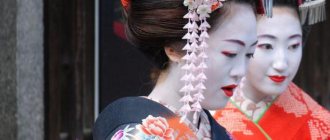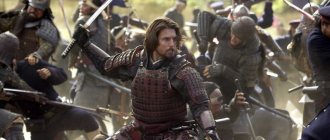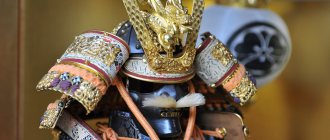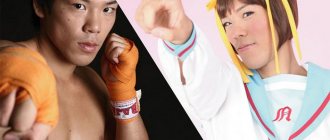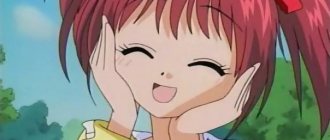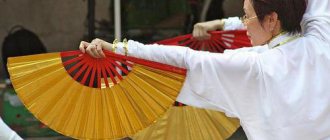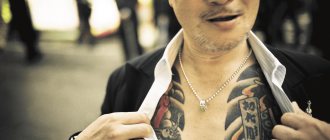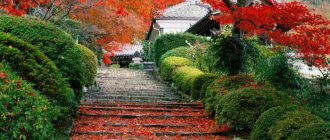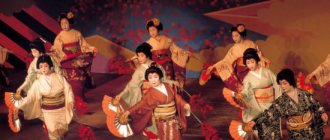Author: Eva Tushenkina
28 April 2021 13:48
Community: Historical facts
Tags: Historical facts Japan bushi-do history of the samurai code of the samurai colorized pictures samurai samurai
2042
20
The samurai in Japan were a class of people who served the aristocracy with weapons in their hands. The word first appeared in a Heian period document; Before this, such people were called mono-no-fu or bushi. "Mono" means "thing" and "fu" means "person"; that is, these are people who deal with certain things - in this case, by “things” we mean weapons.
Group of samurai, 1900
0
Source:
See all photos in the gallery
The word "bushi" means "man of arms". Another Heian period document listing various professions mentions bushi along with other specialists such as literati, doctors, singers, dancers, and others. As numerous studies have shown, samurai were neither landowners nor armed farmers; from the very beginning they were professional warriors. They were well-paid servants of daimyo (large landowners-feudal lords). Samurai had high prestige and special privileges, such as carrying two swords.
0
Source:
Samurai warriors lived according to bushido, a code of conduct that covered almost all areas of life. Bushido demanded from the samurai absolute loyalty and obedience to his master. He must gladly face danger, even death, in the performance of his duties. The Hagakure, a collection of eighteenth-century writings on bushido, proclaims: “The way of the samurai is death... When the samurai constantly prepares for death, he... can unerringly devote his life to the service of his master.” A samurai who failed his master incurred dishonor worse than death. There was only one way to erase the shame. The samurai had to commit ritual suicide - seppuku, sometimes called hara-kiri, or "stomach sitting." He cut his stomach and freed his spirit with a short sword.
Origin
You may be interested in: Author's program - what is it, definition, description and structure
The culture of samurai appeared in 646, after very large political and social reforms in Japan. At that time, there were many internal conflicts among the nobility, feudal lords and large landowners in the country. Most often they were resolved with the help of weapons.
Influential families decided to attract professional warriors for their protection. It was during that period that an unwritten code of honor and morality for the samurai was formed, which was called “The Way of the Horse and the Bow” (“Kyuba no Michi”). It was he who formed the basis of the Bushido code. Large feudal lords attracted samurai as protectors and servants, thereby protecting themselves.
By the 13th century, the shogunate was formed, after a long and bloody civil war, which became the catalyst for its formation. This is the highest government of all samurai classes, headed by the supreme commander, the shogun. At the same time, the symbolism of the samurai was finally formed.
Two samurai in firefighter costumes. 1865
0
Source:
The samurai knew the value of honesty. “Never tell a word or half a lie,” wrote samurai warlord Hojo Soun in the 1400s. Soun also advised his samurai followers to study poetry, read and write. “Keep literary skills in your left hand,” he wrote, “and martial [military] skills in your right. This has been the law since ancient times."
Heraldry and symbolism of samurai and their meaning
Heraldry and symbolism in Japan played a very important role, just as in European countries during the Middle Ages. That is, an emblem or symbol helped to identify which clan the samurai belonged to and which master he served.
Samurai symbols (mons) were an important element in life, and especially during battle. If medieval European knights placed their coats of arms and symbols on their shields, the samurai, unlike them, wore them on their armor or clothing.
These samurai symbols also helped to identify a warrior if he died on the battlefield. The victorious samurai or soldier could cut off the head of the fallen man, and, together with the uma-jirusi (sign, symbol), bring proof of victory to his master.
Uma-jirushi or "horse insignia" are the standards of various generals. They were in the hands of the rider and attached to a long pole. These insignia were used by the commander to command the army during the battle. Japanese insignia was simpler in comparison with European ones and therefore more understandable. Due to this, it was possible to quickly issue commands to the soldiers.
Samurai in armor, 1867
0
Source:
During the Tokugawa Shogunate (1603-1868), many samurai became bureaucrats rather than warriors. Without any wars or conflicts for over a hundred years, the samurai were beginning to lose their original purpose and ideology.
0
Source:
In the end, Emperor Meiji deprived the samurai of many privileges. They were rejected as Japan's only army and replaced with a Western-style conscription-based army. Samurai lost many of their social positions - such as the exclusive right to carry swords or attack commoners for disrespect.
0
Source:
Many samurai eventually joined the military or became government employees, went to study abroad, and became the academic elite. However, after the end of the Meiji Restoration, the era of the samurai officially ceased to exist.
Samurai weapons
The main weapons of the samurai were two swords called “daisho”. From the 14th to the 19th century they were replaced by wakizashi and katana. In addition, the warrior had a long bow, which he mastered perfectly. It should be noted that samurai treated their weapons with great care and respect, considering them sacred. On the blades of the sword, its guard and hilt there were samurai symbols that spoke of his belonging to the clan and his status.
In addition to weapons, samurai had armor. They consisted of many metal plates that were tightly laced to each other. Authentic samurai armor, which amazes with its reliability and beauty, has survived to this day. Also in Japanese museums you can see the uniforms of those whom the samurai served. This armor is distinguished by expensive finishing and decoration.
The warriors, in addition to the above weapons, had a special ritual tanto knife (kusungobu), which they used when carrying out seppuku, known throughout the world as hara-kiri. In essence, this is a ritual suicide, "harakiri" translated from Japanese means "ripping open the abdomen."
The main symbol of a samurai is, of course, his sword. It is worth noting that the warrior did not immediately receive it. When learning the samurai lifestyle and martial arts, young people had the opportunity to use a wooden sword. And only after they became real warriors, they were given a metal katana. It was a symbol of their maturity and confirmation that they had learned the philosophy of the samurai and Bushido.
Other symbols of Japanese samurai
The meaning of the distinctive element in military equipment called "horo" is very interesting. Horo was a cape made of fabric, which was stretched over a special frame woven from elastic bamboo rods. The cape was a mandatory attribute of a samurai's military equipment, located behind his back.
It was intended to allow the rider to be recognized from afar. The thing is that when the samurai rode on a horse, wind currents lifted his cape, and it could be seen and identified. It was convenient in cases where a warrior went somewhere with important data or an order from a master.
Samurai.
Samurai were expected to lead their lives according to the ethical code of bushido ("way of the warrior"). Strictly Confucian in nature, Bushido emphasized concepts such as loyalty to one's master, self-discipline, and respectful, ethical behavior. Many samurai were also drawn to the teachings and practice of Zen Buddhism.
SAMURAI: HISTORY, AESTHETICS AND LIFESTYLE
Feared and respected, the samurai warrior has been known for centuries as an elite soldier and master of Japanese martial arts. This is a warrior who does not shy away from anything and protects his shogun (military leader or daimyo) without sparing his life. By giving his life to the general, the samurai follows the path of the sword, also called bushido. Bushido is a strict code in which loyalty and respect are of paramount importance. The samurai was depicted in books and art early in Japanese history and can be compared to the elite units of the army.
Modern Samurai
The term "samurai" officially comes from pre-industrial Japan (between 1000 and 1900) and literally means "one who serves" or a warrior who follows the bushido code to serve his shogun.
The samurai is a master in fighting with the sword. With the help of his katana (daito, long sword), he strives through bushido to achieve one ultimate goal in his life, to die in battle.
Samurai Rangers
The popularity of samurai led to the appearance of various books, cartoons, films and TV series telling about their lives. This is how the television series “Samurai Rangers” appeared, which is designed for a children's audience. It has very little in common with real life, but is popular in certain circles.
Like real ones, samurai rangers have their own symbolism, which has its own meaning and meaning for each character in the film. The symbols of the Samurai Rangers are water, earth, fire, light, tree and sky (paradise).
However, films and books about real samurai only partially reveal the truth about their lives. Warriors and everything connected with them have a lot of secrets and taboos that are not revealed to a wider audience. In all likelihood, these warriors, who have a centuries-old history, customs and rituals, will remain a mystery to the rest of the world.
Source
Samurai life
Samurai protected the powerful and wealthy Japanese with their lives and their mastery of the Japanese katana sword. The samurai's complete dedication of life to his masters was also called the " way of the warrior" or "bushido". This meant that the warriors were inseparable from their sword and tried to "unite" with it in death, protecting their master.
The country was eventually reunified in the late 1500s, and a rigid social caste system was created during the Edo period, with samurai at the top, followed by farmers, artisans, and merchants respectively. During this time, samurai were forced to live in castle towns, they were the only ones allowed to own and carry swords, their daimyo or feudal lords paid their wages in rice. Masterless samurai were called ronin and caused significant problems during the 1600s.
The master of the “drunken” sword of the Oita school peed on the students.
They spent many hours a day practicing and perfecting martial arts. They spent months working on the perfect kata for their favorite way of fighting. In addition, the sword always had to be carried with you, because it was the soul of the samurai (and for safety in those difficult times). If he lost his katana, it was a great shame and often led to the commission of seppuku or hara-kiri, which literally means suicide by cutting open the abdomen. By committing seppuku, samurai demonstrated their courage in the face of pain and death and the purity of their thoughts before gods and people.
Many members of the Yakuza, bandits in Russian, still follow the path of Bushido.
Japanese warriors became increasingly famous during the unification of Japan by Emperor Kammu. Emperor Kammu used them to suppress civil uprisings in order to create a unified Japan. Over the years, samurai sword techniques have evolved and this skill is called Ken-jutsu, which is a part of Budo, also known as Japanese martial arts. Now this is, for example, jiu-jitsu and relatively modern karate and judo.
Mastery of martial arts was considered one of the pillars of the legendary status of the samurai, who mastered the technique of self-defense without weapons (jiu-jitsu). Other important aspects of understanding the harmony of life and the path of bushido were the improvement of calligraphy and ikebana (flower arranging). These forms of striving for excellence are still deeply woven into modern Japanese culture.
The fastest modern samurai is Isao Machii

